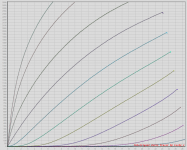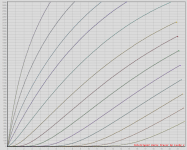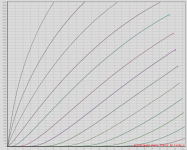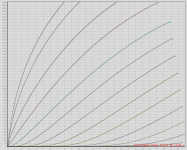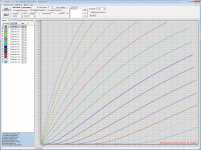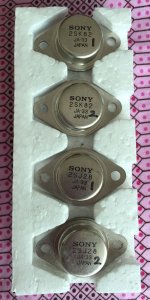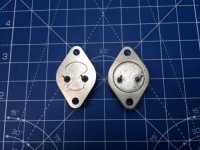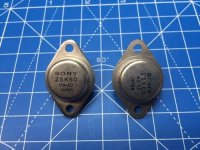2SK82 being unobtainum now,will there be any issues in getting this part to work?
Just a thought; maybe one can make a quasi-complementary 2SK82 by compounding 2SJ28 with a low power NPN or FET. The FET may preferably be a low power N-VFET to take full advantage of the triode-like properties of the resultant quasi. Mr. Go of circuitdiy recently reported that he has a large supply of 2SJ28. I recently bought 6 units.
if only this amp designed with common source mode.
which the original vfet character will be appear. (in my opinion)
True of all parts comparing Common Drain and Common Source.
VFET in Common Drain is still different than Mosfet for example.
I just noticed that one of the 2SK82 I got to make the single pair version reads JF-33,as compared to KE-33 2SK82s that everone has.
I have no equipment immediately on hand to measure not even a cheap multimeter,but going just by looks,the printing is different compared to the rest of the VFETs, the case is matte,as opposed to the shinier cases of the others and a slight difference in can curvature. Is anything amiss?
I ask because of this-
2SK82 being unobtainum now,will there be any issues in getting this part to work?
That was a knee jerk reaction,boosted by the fact that a known counterfeiter on the bay has used a similar image for his listing.
A member on another site who says-
Plus,they have been through a curve tracer and are reported good.Also reported good testing with a multimeter for D-S resistance and diode tests.The letters before the numbers are batch codes. Unfortunately, to my knowledge, no data exists as to what batch code means what date of production. It also seems that there were subtle changes made to the manufacturing process between batches as well as subtle changes to the shape of the TO3 case.
A simple google and forums search search usually throws up all you need to know
 atleast most of the time.
atleast most of the time.... Also reported good testing with a multimeter for D-S resistance and diode tests ...
I believe you're referring to the 2SK82s that I sent you. Good to hear that the multi-meter test results are positive
I don't remember which exact 2SK82s I sent you, but if their marking is JF33 the hand-written number on them must be between 1-4. I happen to have kept their curve data, so here it is for your reference.
Attachments
I believe you're referring to the 2SK82s that I sent you. Good to hear that the multi-meter test results are positive
I don't remember which exact 2SK82s I sent you, but if their marking is JF33 the hand-written number on them must be between 1-4. I happen to have kept their curve data, so here it is for your reference.
They look a lot like the ones I have, assuming similar axis scales.
I haven't run across any samples that didn't work fine, and if paralleling
parts I think you can just use Vgs matching and be happy.
could you suggest a curve in follower mode from Vfets?, I tried to think how work extrapolating from the ED/ID with G polarization, and the E(G) over ID with curves over VD.
Best regards
As above, if they are of the generic type, just go by the Vgs measure. If you
try to deal with all the other possibilities within a given part, you're going to
end up over-thinking it.
... and if paralleling parts I think you can just use Vgs matching and be happy ...
Thanks Mr. Pass, definitely agree. As I sold the parts to another forum member, I just wanted to show him that the parts are good.
I am building Michael's LuminAria lately, and I realized that matching curves doesn't necessarily give what I want in circuit, measuring the devices in the actual circuit are far more useful.
Dear Mr Pass, thank you very much for your time.
Is true like you said, I over think.
But now, that you actually answer me, further I feeling lucky, probably I not make a clearly the question, idiomatic problems are the first problems for me, but they are not caming to the case.
My specifically question is about the envelope of the cathode follower or the source follower on the Vfet system. We adopt the vfet traces for the y=x3/2 character curve that give us the gently round clipping. Does the same envelope is make in the followers ?
Is true like you said, I over think.
But now, that you actually answer me, further I feeling lucky, probably I not make a clearly the question, idiomatic problems are the first problems for me, but they are not caming to the case.
My specifically question is about the envelope of the cathode follower or the source follower on the Vfet system. We adopt the vfet traces for the y=x3/2 character curve that give us the gently round clipping. Does the same envelope is make in the followers ?
JA-33
To be sure I didn't refer a bad source to this forum, I ordered 2 pairs of VFET from the shop that I mentioned in post #76, I received them today and they're having markings of JA-33.
I measured them and they look genuine to me (curve of one sample attached), though the required bias level maybe slightly different with the KE-33s.
... I'm so lucky that i have a colleague worker who is located in china and help me to buy 4pairs (is it enough?), and hopefully they are genuine ...
To be sure I didn't refer a bad source to this forum, I ordered 2 pairs of VFET from the shop that I mentioned in post #76, I received them today and they're having markings of JA-33.
I measured them and they look genuine to me (curve of one sample attached), though the required bias level maybe slightly different with the KE-33s.
Attachments
I believe you're referring to the 2SK82s that I sent you. Good to hear that the multi-meter test results are positive
I don't remember which exact 2SK82s I sent you, but if their marking is JF33 the hand-written number on them must be between 1-4. I happen to have kept their curve data, so here it is for your reference.
Yes indeed.The can marked 1.
I didnt want to take your name as I was doing the classic newbie first forum post-crying wolf without doing my research(despite the assurance given by you).
More like,I was thinking on the lines of J and K being like different HFE grades on BJTs,so I would have a issue getting proper setup.Now,since its just the production code,with the grade 33 being same,I think there is no such issue,I hope.
My sincere apologies!
Another member has identified Aliexpress as a source before (Aliexpress.com : Buy SONY 2SK82 V FET from Reliable fet transistors suppliers on Eternal HONG's store | Alibaba Group), and they seem to have almost a thousand pieces of JA-33 2SK82 available.
Aliexpress do not deliver to Hong Kong (they sell stuffs from TB to foreign countries, at a somewhat higher price), so I can't try them, but brave souls in Europe or US may order one and see if they're authentic.
Aliexpress do not deliver to Hong Kong (they sell stuffs from TB to foreign countries, at a somewhat higher price), so I can't try them, but brave souls in Europe or US may order one and see if they're authentic.
I have noticed that genuine Sony parts in general have the markings oriented along the long axis of the part and they are flat (smooth) on the bottom. The fake Sony parts I've gotten from various places, have the text oriented along the short axis and they have circles and other markings on the bottom of the part (because they are re-marked samples of whatever was lying around  ) Just FYI, for what it may be worth.
) Just FYI, for what it may be worth.
... My sincere apologies!
No apology is needed
This is exactly the reason I'm afraid to run a group buy, despite it could benefit many forum members, and it's still not very difficult to get these parts in quantity in China.
To be sure I didn't refer a bad source to this forum, I ordered 2 pairs of VFET from the shop that I mentioned in post #76, I received them today and they're having markings of JA-33.
I measured them and they look genuine to me (curve of one sample attached), though the required bias level maybe slightly different with the KE-33s.
Thank you for taking the chance and letting us know. Other members
can decide based on your experience whether it's something they
feel comfortable pursuing.
Cheers,
Dennis
I have noticed that genuine Sony parts in general have the markings oriented along the long axis of the part and they are flat (smooth) on the bottom. The fake Sony parts I've gotten from various places, have the text oriented along the short axis and they have circles and other markings on the bottom of the part (because they are re-marked samples of whatever was lying around) Just FYI, for what it may be worth.
I should make a correction to that comment:
The real Sony's have a ring around the bottom, the fake parts are flat or have a shape like the one shown in the photo.
In both pictures, the real part is on the right.
Attachments
- Home
- Amplifiers
- Pass Labs
- Sony VFET Amplifier Part 2
